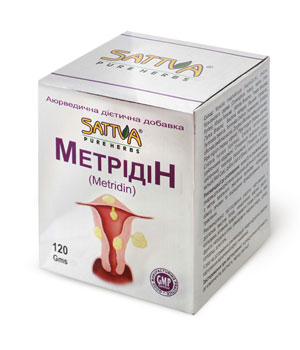Health Problems
Subscribe Newsletter
AYURVEDIC FORMULA FOR THE FEMALE REPRODUCTIVE SYSTEM
Metridin
120 Gm
Uterine fibroids - the most common tumor in women. According to various estimates, it occurs in every two to four women during the reproductive years, especially after 30 years.
Uterine fibroids - a benign tumor that occurs in the uterine muscle layer (endometrium). It manifests itself in the emergence of nodes on the uterus growing in different directions: to the outside, inside the uterine cavity, or continues to grow inside the uterus. there are several names of this diseases: Uterine Fibroid, Fibroids, Uterine Leiomyoma, Myoma.
Fibroids is a chaotic tangle of intertwined fibers and smooth muscle found in the form of a rounded shape node. Most nodes have a diameter from several millimeters to several centimeters.
Each node fibroids occur due to improper division of one smooth muscle cells, and therefore all the cells in the node are identical. Uterine fibroids is considered hormone-dependent tumors. Proof of this are the following factors:
- Detection in tumor receptors to sex hormones;
- The appearance of fibroids during their reproductive years, when estrogen levels are high;
- Tumors regress after menopause when the estrogen level reaches a minimum;
- The appearance of fibroids in some postmenopausal women while taking estrogen drugs.
The most common symptoms of uterine fibroids are menstrual bleeding (menorrhagia), feeling of pressure and pain in the abdomen. With the growth of fibroids menstruation gradually become more abundant and prolonged, often leading to the development of anemia (anemia).
Most fibroids have psychosomatic causes, i.e., their appearance provokes some negative emotion, or a series of events. The tumor grows from resentment on men and a lack of progesterone. "If you remember, and literally are carrying a inflicted insult from the man or husband - beware! - Uterine fibroids - a bomb dangerous action, which arises from of the claims and grievances on men. All you need is to forgive them and let them go, and then the fibroids will go, " (Valery Sinelnikov).
Special measures for the prevention of uterine fibroids does not exist. It should be an annual thorough investigation of the woman's body.
With long-term course of the disease, there are violations of ovarian function, until the lack of ovulation, or violation of the corpus luteum function, which leads to significant hormonal shifts. These changes are considered to be a motivating factor in the development of cystic changes of ovaries and endometrial hyperplasia.
Endometrial hyperplasia - is excessive growth of the uterine lining (endometrium), in which it becomes much thicker than normal.
Lead time in the cause of occurrence and the further development of endometrial hyperplasia belongs hyperestrogenism - raising the level of the hormone estrogen. The duration of action of hormones estrogen increases the number of endometrial cells: mucous thickens, elongated gland, they are formed of expansion.
Risk factors for this disease are:- климактерический период;
- Obesity;
- diabetes;
- arterial hypertension;
- Later (after 50 years) menopause.
For endometrial hyperplasia it is characterized by the so-called dysfunctional uterine bleeding. The intensive nature of bleeding often occurs during puberty, but can also be in women of reproductive age and the elderly. Some patients with hyperplasic processes proceed with Just noticeable signs or symptoms. Hyperplasic processes are usually accompanied by infertility.
Depending on the type of hyperplastic process is isolated:
- Typical hyperplasia
- Atypical (atypical) hyperplasia.
A typical hyperplasia is a serious disease because of the high probability of degeneration into a malignant tumor. The threat of degeneration to cancer (endometrial cancer), without treatment, ranges from 20% to 81%, and most often occurs during menopause. Local, limited form of hyperplasia of the endometrial called endometrial polyps.
There are various approaches to the treatment of these diseases. The most common include surgery - a hysterectomy, and MR-guided focused ultrasound surgery manageable. There are also various herbal treatment options. Apply non-specific anti-tumor and plants, the so-called queen cells - by plants regulators trophism of the connective tissue, immune-regulators and adaptogens.
Ayurvedic plants such as Ashoka, Citraka, Kumar, Guggul, Neem, Manjhishta and others, in conjunction with Ayurvedic minerals, able to "dissolve" the tumor. Citraka helps get rid of fibroids. Ashoka relaxes the uterus, reduces menstrual flow, helps to remove tumors or fibroids in connection with his "scraping" - qualities. All these plants and minerals are present in the preparation Sattva Metridin.
Benefits
- It relieves women from hysterectomy.
- It protects the uterus from excessive bleeding.
- Completely removes the fibroids are small.
- Significantly reduces fibroid size and large keeps them from further growth.
- Reduces levels of estrogen and stops the growth of fibroids in the uterus.
- Protects against iron deficiency (anemia) due to heavy menstrual bleeding
Sattva Metridin may be useful in a variety of gynecological diseases, such as menorrhagia, dysmenorrhea and heaviness in the lower abdomen due to uterine fibroids.
Sattva Metridin contributes to a narrowing of the small blood vessels, reducing bleeding.
Sattva Metridin can be safely used with endometrial hyperplasia, to reduce bleeding and in different types of tumors in connection with his "scraping" qualities.
Sattva Metridin eliminates congestion in the pelvic area and improves the overall health of the woman.
Main ingredients of Sattva Metridin:
Ashoka (Saraca indica) - a sacred tree in India. According to legend, under this tree the Buddha was born. The Sanskrit name of the tree means "carefree and relieves sadness." Ashoka is a symbol of love and guardian of virginity. Tree bark has anti-inflammatory and astringent properties. It is used for gynecological problems: menorrhagia, dysmenorrhea, uterine inflammatory conditions, whites, internal bleeding. It has a healing effect on the endometrium and stimulates the ovaries. It normalizes the monthly cycle and strengthens the muscles of the uterus.
Lodhra (Symplocos racemosa) - evergreen shrub with dark green leaves and white and yellow fragrant flowers. It grows in the north and east of India and the Himalayas at an altitude of 1400 m above sea level. Part used: bark. It has astringent, anti-inflammatory, hemostatic effect. Used in the menstrual cycle, menorrhagia, tumors, belyah. It narrows the small blood vessels and reduces bleeding. Lodhra contributes to strengthening the fruit and prevents miscarriages. Included in the many ayurvedic formulations for the treatment of gynecological disorders.
Chitrak (Plumbago zeylanica) - using roots, bark and seeds for a variety of medicinal therapies in very small doses. It is used for the correction of the menstrual cycle. It helps reduce estrogen levels.
Guggul (Commiphora mukul) - thorny shrub with red white or yellow flowers and unusual shaped fruit that grows in India. This is one of the most widely used plants in Ayurveda. It has a strong purifying and rejuvenating effects. The raw materials used gum - resins (myrrh), released by the fruit when it is damaged. White milky juice contains gum, resin, essential oils. The fruits are in the form of very dense and peas can be stored for a long time without losing its properties up to seven years. On the basis of guggul is preparing a wide range of Ayurvedic medicines. Resin unique plant has a very strong absorbent action.
Kanchnar (Bauhinia variegata) - is a small deciduous tree native to Southeast Asia. During flowering is almost completely covered with magnificent flowers that resemble orchids. Kanchnar- one of the most famous Ayurvedic plants used for the treatment of tumors. It helps to reduce uterine fibroid tumors.
Daru haridra (Berberis aristata) - a plant with an amazing ability to cleanse the body of toxins. Used bark of barberry. It is used in obstetric practice as a styptic.
Nagkeshar (Mesua ferrea) - Ceylon ironwood. It has astringent, anti-microbial, anti-inflammatory and antipyretic activity. Antiseptic and aphrodisiac. Used for the treatment of menorrhagia.
Guduchi (Tinospora cordifolia) - very large perennial vine. Guduchi - means "that protects you, your body." In Ayurveda guduchi considered efficient and very effective against thousands of diseases, prolonging youth. It is valued as the surest means of active, healthy longevity.
Vitex (Vitex Agnus-Castus) -Avraamovo tree. Threaded bush genus Vitex. It has mostly hormone-activity. Vitex affects the function of the corpus luteum (gland that regulates the menstrual cycle). It improves the function of sexual glands. It is used in the treatment of fibroids, cysts, polyps, menstrual disorders, mastitis, infertility.
Loja Bhasma- Iron oxide (Ash of Iron) - helps with anemia. Included in the hemoglobin of red blood cells, muscle tissue, bone marrow, liver and spleen. Each hemoglobin molecule contains four iron atoms that create reversible and irreversible bond with oxygen to form oxy hemoglobin. The blood containing oxy hemoglobin circulates throughout the body, delivering oxygen to the tissues for cellular respiration. Iron is essential for respiration and the formation of red blood cells.
Rajat Basma - Silver oxide (Ash of Silver) - the perfect anti-inflammatory, antibacterial properties. It suppresses pathogenic microflora. It reduces and removes the tumor.
Suvarna Basma - Gold oxide (Ash of Gold) - is part of the preparations, recoveres the reproductive system and increase vitality. Excellent tool for the prevention and treatment of tumors. Aphrodisiac. It has sustained tonic effect.
Diet and lifestyle.
Diet: eliminate meat and fried food, sweets and alcohol. Eat more plant foods - whole grains, such as wheat, oats, millet and brown rice. Products with essential fatty acids which provide the body with calcium. Seasonal fresh vegetables and fruits: pomegranate, coconut, watermelon, peaches, raisins. Reduce the use of products containing animal proteins, as it increases estrogen levels. Alcohol,caffeine, spicy foods and smoking break down minerals and vitamins of group B. Keep an active lifestyle. Well perform daily exercise. Massage the whole body with Sattva Olyana massage oil.
Ingredients
Ashoka (Saraca indica), Lodhra (Symplocos rasemosa), Chitrak (Plumbago zeylanica), Guggul (Commiphora mukul), Kanchnar (Bauhinia variegata), Daru Haridra (Berberis aristata), Nagkeshar(Mesua ferrea), Guduchi (Tinospora cordifolia), Vitex (Vitex Agnus-Castus), Loh Bhasma (Ash of Iron), Rajat Bhasma (Ash of Silver), Suvarna Bhasma (Ash of Gold).
Dosage
1 teaspoon (2 gm) two times a day 15-20 minutes after meal. Take with a solution of Sattva Suraktam syrup - 15 ml to 50 ml of water.
Indications
fibroids, fibroids, uterine leiomyoma, polyps, endometrial hyperplasia, endometriosis, menorrhagia, dysmenorrhea, menstrual cycle disorders, infertility.
Contradiction
individual intolerance to the components of the preparation, pregnancy and breastfeeding.
Packing
120 grams ± 2% powder in food grade acrylic- metal container.
Storage
Store in a cool dry place, protected from moisture and light, at a temperature no higher than 30 C.

